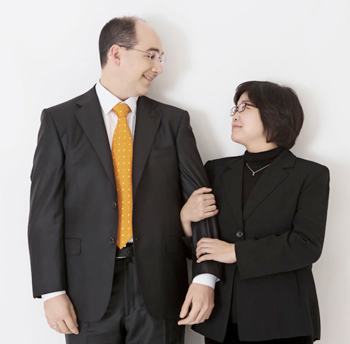by Mike Telin

On Friday, March 10 at 7:00 pm at The Music Settlement, The Cleveland Cello Society will present Mark Kosower and pianist Jee-Won Oh in a recital that will feature works by Beethoven, Brahms, Khachaturian, Martinů, and Schubert.
Kosower said that the cello is one of the most versatile and expressive instruments around. “It’s a remarkable instrument. Few others can compare, in my humble but correct opinion,” he said, laughing. “Its range runs the entire spectrum of the human voice.”
Beginning with an appearance by Janos Starker in 1999, each year The Cleveland Cello Society has presented concerts by local, national, and international soloists and ensembles representing musical styles ranging from classical to jazz and experimental. In additional to Friday’s recital, the current season’s offerings have included performances by students of Richard Aaron from the University of Michigan and by the Los Angeles-based cello quintet SAKURA, as well as a workshop and concert with the New York-based project Cello Solos Today.
The Society also helps to advance the careers of young cellists through its annual scholarship competition. “This is one of the great things they do every year,” Kosower said. “Next year will be the 20th anniversary of CCS, and in that time, they’ve given over $50K in scholarships.”
Kosower said his program will be bookmarked by two virtuosic sets of variations, beginning with Beethoven’s Variations on a theme from Mozart’s Die Zauberflöte. “The aria ‘Bei Männern, welche Liebe fühlen’ is about one character who can’t find a date, and another who is claiming that the prince is in love with her. They both agree that love is grand, and sing about the virtues of it. As is typical of Mozart, the characters are a little bit ridiculous, but Beethoven writes these seven variations with such variety and embellishment that they’re fascinating from beginning to end. The variations are virtuosic, but the dichotomy between the frivolous and the profound is what makes the piece so engaging.”
The evening will conclude with Martinů’s Variations on a Theme of Rossini, based on a theme taken from Rossini’s opera Moses in Egypt. Kosower noted that while the aria speaks to the prayer of the Israelites, the Czech composer utilizes some of the opera’s more “upbeat” music.
Originally written for violin, Johannes Brahms’s Sonata in D, Op. 78 was later arranged for cello and piano by Paul Klengel, the brother of the famous German cello teacher Julius Klengel, whose students included Gregor Piatigorsky and Emanuel Feuermann.
“Part of Brahms’s motivation for composing this sonata was the death of Clara Schumann’s young son Felix,” Kosower said. “Brahms uses a song which is nostalgic for the days of his youth — enjoying being in the rain, feeling the grass, and dreaming of life and the future. The finale deals with oncoming death from the broader perspective of the passage of time. Brahms made an interesting comment about this piece. He said, ‘The melodies fly so thick in opus 78 that you have to be careful not to step on one.’”
Kosower said the same is true of Schubert’s ‘Arpeggione’ Sonata. Written for the now obsolete arpeggione, a six-string bowed guitar, the Sonata is filled with Austrian folk music. “The final movement is so beautiful and episodic with story-telling, but still has the underlying melancholy and sadness that is always present in his music. Both this and the Brahms are great examples of Austrian and German Lieder for cello and piano.”
The cellist noted that Karen Khachaturian’s four-movement Sonata, composed for Mstislav Rostropovich, is defined by its rhythmic drive and use of slow, overlapping melodies. “Karen is the nephew of Aram Khachaturian, but Karen was a Russian, and this sonata comes from the heart of Soviet times. I find this piece very much in the same vein as Shostakovich, with its juxtaposition of everyday life and life under a repressive regime — and the sarcasm that resulted from those two worlds.”
When not performing with the Orchestra or giving recitals, Mark Kosower is an active recording artist. His CD of both Ginastera Concertos with the Bamberg Symphony Orchestra was released in 2011. He’s also recorded both of Victor Herbert’s Concertos with the Ulster Orchestra.
“I have a CD coming out this year that includes Max Reger’s Sonata No. 4 and the Strauss Romance, along with a sonata by the contemporary German composer Eberhard Klemmstein. In June, I’ll be recording Klemmstein’s Concerto with the Slovak Radio Orchestra, and in September Jee-Won and I will go to Hanover to record the two Brahms Cello Sonatas and the Op. 78. It’s a big recording year with all three of these, and I’m pretty excited about it.”
For Mark Kosower, the best part of this Friday’s recital is the opportunity to perform with Jee-Won Oh. “It’s a joy to make music with my professional partner and spouse. It’s always special to get to do that. You’re only as good as your partner when you play anything, and she makes me look good.”
Published on ClevelandClassical.com March 7, 2017.
Click here for a printable copy of this article



